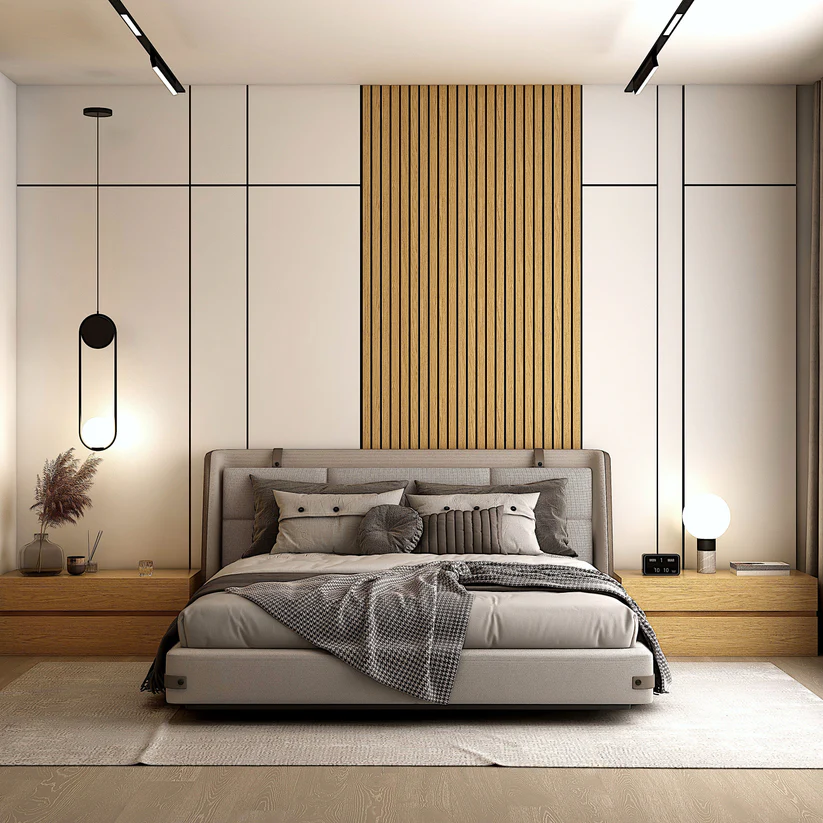Struggling with echoey rooms or noisy spaces? It’s annoying when sound bounces everywhere, ruining focus or relaxation. Acoustic wood panels could be the stylish fix you’re looking for.
Acoustic wood panels enhance room acoustics by absorbing sound waves, cutting down echo and reverberation. Their porous surface and backing materials trap sound energy, boosting clarity and comfort in any space.
acoustic wood panels
But how do these panels actually work? And why is wood such a smart choice? Stick with me as I explore how acoustic wood panels can transform your space.
Is wood paneling good for acoustics?
Wondering if wood paneling can really fix your room’s sound? It’s easy to doubt, but wood has some impressive acoustic tricks up its sleeve.
Yes, wood paneling is great for acoustics. Its natural density and texture absorb and scatter sound waves, reducing echo and improving sound quality in a room.
wood paneling acoustics
Why Wood Shines in Acoustics
I’ve always been fascinated by how simple materials can solve big problems. Wood paneling works so well because of its natural makeup. The tiny air pockets in wood trap sound waves. When sound hits the surface, it gets caught in these pockets and loses energy. This cuts down on echo and makes rooms feel quieter.
The texture of wood helps too. Unlike flat surfaces that bounce sound straight back, wood’s grain or slats scatter it in different directions. This diffusion softens the noise. At NF Decor, our wooden slat acoustic panels take this further with veneered strips and felt backing. They’re built to soak up sound while looking good.
Different woods do different things. Soft woods like cedar grab high-pitched sounds. Harder ones like oak tackle lower tones. Even the finish matters—unfinished wood absorbs more than sealed surfaces. I once helped a client in Canada, a distributor named Leon, pick oak panels for his office project. He loved how they balanced sound and style.
Do acoustic panels improve sound quality?
Sick of fuzzy audio in your home theater or garbled voices in meetings? Bad sound can ruin any space, but acoustic panels might save the day.
Yes, acoustic panels improve sound quality a lot. They cut unwanted reflections and soak up extra noise, giving you clearer audio for music, speech, or anything else.
acoustic panels sound quality
How Panels Boost Your Listening Experience
Sound quality matters to me because I’ve seen how it changes a room. Hard surfaces reflect sound waves, creating echoes or muddy audio. Acoustic panels stop that. They absorb mid and high frequencies—like voices or guitar notes—making everything sharper.
Reverberation is a big issue too. It’s when sound lingers after the source stops. Panels shorten that time, so speech stays clear. In a home theater, they help you hear every detail. I remember installing our hexagon acoustic panels for a client in the UK. He said his movie nights went from messy to amazing.
Placement is key. Put panels where sound first hits—like walls near speakers—and you’ll notice a difference. Here’s a quick guide to reverberation times:
| Room Type | Ideal Time (seconds) |
|---|---|
| Home Theater | 0.3 – 0.5 |
| Office | 0.6 – 0.8 |
| Living Room | 0.4 – 0.6 |
Our panels at NF Decor, like the 3D acoustic felt ones, are perfect for tweaking acoustics to fit your needs.
Do acoustic panels keep sound in a room?
Need to stop noise from escaping a room? Whether it’s for privacy or keeping peace, you might hope acoustic panels can lock sound in.
Acoustic panels mainly absorb sound inside a room and can reduce some leakage to other spaces. For full soundproofing, though, you’ll need extra steps.
Absorption Isn’t the Same as Blocking
I get this question a lot at trade shows. People mix up absorption and soundproofing. Absorption is what our panels do best. They grab sound waves inside the room, so less bounces around or sneaks out. This helps if you’re in an office and don’t want chatter spilling into the hall.
But soundproofing is different. It stops sound from passing through walls. Panels alone won’t fully block noise—think of them as a helper, not a wall. To keep sound in, you’d need to seal gaps or add heavy materials like extra drywall. I once advised a construction company in the USA to pair our felt wall panels with sealed doors. It worked wonders for their meeting rooms.
Our wooden slat panels do cut down some transmission, especially on shared walls. They’re a solid start for quieter spaces, but for total privacy, you’ll need more.
Why is wood good for acoustics?
Curious why wood keeps popping up in acoustic fixes? It’s not just pretty—wood has special traits that make it a sound superstar.
Wood is great for acoustics because its density absorbs sound and its texture scatters it. Plus, it brings a cozy, stylish vibe to any room.
wood acoustics
What Makes Wood a Sound Hero
Wood’s magic comes from its structure. Its tiny pores trap sound waves, turning noise into tiny bits of heat. This works best for voices and music. Density plays a role too—denser woods like oak soak up more sound than lighter ones like pine.
The surface helps as well. Wood’s natural grain or slats break up sound waves, spreading them out instead of bouncing them back. At NF Decor, we boost this with felt backings on our panels. It’s a combo that really sings.
Each wood type has its strengths. Oak handles bass notes. Cedar softens treble. I worked with a Malaysian client who chose pine for his café—it softened the chatter perfectly. Wood’s look is a bonus too. Unlike foam, it fits any style, from modern to rustic. Our panels prove you don’t have to pick between function and beauty.
Conclusion
Acoustic wood panels cut echo, boost sound quality, and help contain noise. With their natural charm and solid performance, they’re a top pick for any space.

